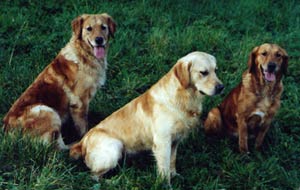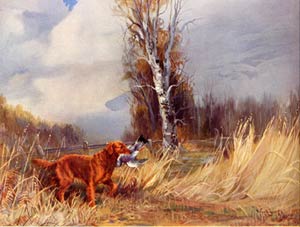
| The Golden Retriever |
|
Golden Retriever by R Ward Binks |
|||||||||||||||||||||||||||||||||||||||
| Although the
Golden Retriever is one of the most recently developed retrievers
it was not until 1960 that the true origin of the breed became known.
Prior to Mrs Elma Stonex's book. The Golden
Retriever, published in 1952, the most commonly accepted origin
of the breed was that it had been developed from a troupe of Russian
circus dogs bought by Lord Tweedmouth during a visit to Brighton.
The Russian circus dog story of origin became the accepted version
of the beginnings of the breed and appeared in the Crufts catalogue
until 1960. One of the greatest proponents of this theory was
Colonel Le Poer Trench who had his St. Hubert's strain registered
with the Kennel Club as retrievers (Russian Yellow). |
|||||||||||||||||||||||||||||||||||||||
|
THE MIDAS TOUCH
(The Golden Retriever) The Golden Retriever,
I'd say for a start, |
|||||||||||||||||||||||||||||||||||||||
 Goldens from the Ruadth Kennels |
|||||||||||||||||||||||||||||||||||||||
| However the true history
of the breed was first published by Lord Ilchester in 1952 in an
article in the Country Life entitled "The Origin of the Yellow
Retriever". This was based on over ten years of research by
Mrs Stonex and in 1959 she and Lord Ilchester put their findings
to the Kennel Club. In 1960 the Crufts catalogue carried the true origins of the breed as approved by the Kennel Club: "Description of the Golden Retriever 'The origin of the Golden Retriever is less obscure than most of the Retriever varieties, as the breed was definitely started by the first Lord Tweedmouth last century, as shown in his carefully kept private stud book and notes, first brought to light by his great-nephew, the Earl of Ilchester, in 1952. In 1868 Lord Tweedmouth mated a yellow Wavy-Coated retriever (Nous) he had bought from a cobbler in Brighton (bred by Lord Chichester) to a Tweed Water Spaniel (Belle) from Ladykirk on the Tweed. These Tweed Water-Spaniels, rare except in the Border Country, are described by authorities of the time as like a small Retriever, liver-coloured and curly-coated. Lord Tweedmouth methodically line-bred down from this mating between 1868 and 1890, using another Tweed Water-Spaniel, and outcrosses of two black Retrievers, an Irish Setter and a sandy coloured Bloodhound. (It is now known that one of the most influential Kennels in the first part of the century which lies behind all present day Golden Retrievers was founded on stock bred by Lord Tweedmouth.)" From this description it can be seen that all Golden Retrievers go back to the yellow retriever Nous who himself was obviously the produce of Flat - coated Retrievers. Many canine authorities of the day including Rawdon Lee in his Modern Dogs (1893) referred to brown retrievers including pale chocolate coloured dogs being bred from black parents. In the pedigree of Prim and Rose, the last two yellow retrievers recorded in Lord Tweedsmouth's records, one can see the influence of both the Flat-coated Retriever and the Tweed Water Spaniel in the development of the Golden Retriever. The Tweed Water Spaniel is now extinct but writers of the time including Stonehenge in The Dog (1859), Vero Shaw The Book of the Dog (1890), give detailed descriptions of the Tweed Water Spaniel as a small type of retriever used by fishermen in the borders between Scotland and England. The type of flatcoats used in the breeding programme to produce Prim and Rose were very much of the old golden type in head and conformation rather than having the construction and head of the modern flatcoat. Zelstone, Think and Tracer were all from the breeding of S.E. Shirley and photographs of Ch Moonstone (Brother to Tracer) published in Nancy Laughton's "A review of the Flat-coated Retriever" (1968) and Thoughtful (sister of Tracer) published in Sir Henry Smith's, "Retrievers and how to break them" (1898) show dogs very much of the early golden type. One other throw back to the flat coat ancestry is the presence of a few black hairs on some of even the lightest goldens. More uniquely one of our more experienced breeders has told me that in one of her very early litters she had an almost totally black puppy. Unfortunately she put this puppy down at birth. The link between Prim and Rose to Culham Viscount Harcourt's Cluham Brass (the dog behind most of today's pedigrees) is via a bitch called Lady who was thought to be a daughter of Prim or Rose. Other Guisachan bred dogs that can be traced through early pedigrees are Conan and Rock. To summarise the origins of the breed, I think it fitting to quote from Mrs Stonex's book: "The influential recorded links of Guisachan bred Lady, Conon and Rock, prove the descent of today's Goldens from the first Lord Tweedmouth's thoughtfully planned matings on a foundation of a yellow retriever of unknown antecedents (Nous) and two Tweed water spaniels (Belle and Tweed). The roots of the breed lie in Scotland and the Border Country." |
|||||||||||||||||||||||||||||||||||||||
|
|||||||||||||||||||||||||||||||||||||||
|
|||||||||||||||||||||||||||||||||||||||
|
|||||||||||||||||||||||||||||||||||||||
|
|||||||||||||||||||||||||||||||||||||||
|
|
|||||||||||||||||||||||||||||||||||||||
